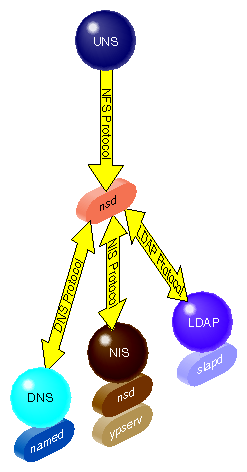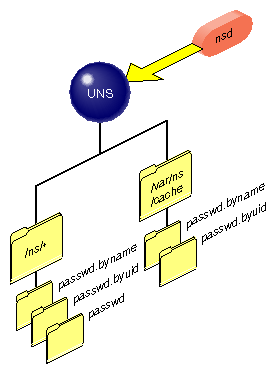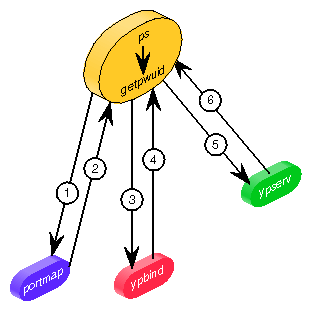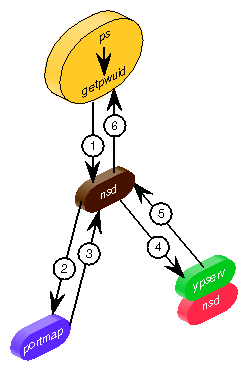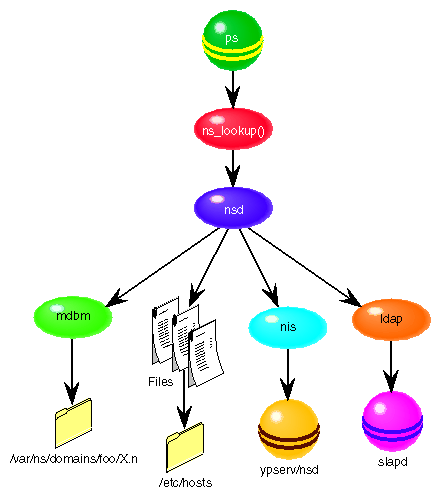The Unified Name Service (UNS) is a name service layer provided with the IRIX operating system to translate and simplify name service requests. Name servers provide network services that enable clients to name resources or objects in the network and share this information with other network objects.
In the past, each new name service was implemented in an application using code in the standard C library. As a new name service was added to a network, configuration files representing information about system resources and accounts were added along with a number of library routines. When the concept of distributed name space administration was conceived, the process became more complex.
To simplify this, the unification layer provided by UNS was developed. All IRIX networked programs can use UNS to implement other name services.
The following subjects are discussed in this chapter:
UNS translates the results of name service requests from a number of different protocols into a single file-based protocol. A protocol is a set of rules, data formats and conventions that determine how data is transferred between network components. A library is the implementation of a protocol. Among several standard protocols that the IRIX operating system provides are the protocols DNS and NIS which deal with name service requests. Given multiple protocols, a single overriding protocol simplifies name service requests.
Unified Name Service has three major components:
the name service daemon nsd
specific application programming interface (API) routines in the C library
several protocol libraries
The name service API is left unchanged from previous releases of the IRIX operating system to maintain library-level compatibility. No applications should need to recompile to take advantage of UNS components.
At system start up, the daemon nsd takes two actions: it initiates a filesystem namespace rooted at /ns. It then reads the UNS configuration file /etc/nsswitch.conf which specifies the resolve order of each of the supported tables, and protocols.
The daemon nsd has no awareness of protocols itself, it simply sets up a front-end interface to the different name services and runs between them. If a request comes from NIS to resolve a password into a system name, nsd passes the request to the appropriate library based on the resolution of the request pathname. A request issued from NIS /etc/passwd, for example, is passed to /ns/.local/.nis/passwd, so that in effect UNS acts as an alias.
When the nsd daemon is called, it reads the configuration file nsswitch.conf, which contains a list of protocols and tables. A table is made up of searchable rows and columns. The hosts table consisting of hosts.byname and hosts.byaddr, effectively allows a search either by hostname or by host address.
The file system namespace started by nsd is rooted at /ns and is used by the underlying interfaces to retrieve name system data. This is a dynamic file system, timed out after 30 seconds, so that if you issue the command ls from /ns you may not see the files.
The results of any name search are held in the .local cache file in the /ns namespace. The .local file is the local user's view of the namespace. When a file is accessed in the /ns directory, an entry is added to a cache file under /var/ns/cache, creating what is in effect a shadow file. There is a cache file for each of the tables supported by the name service daemon. For example, if a call comes to NIS, the NIS database files on the local host are searched first. This means network traffic is reduced and searches are swifter.
The format of these files mimics the format of the historic configuration files that they replace. Using passwd as an example, each file under the directories /ns/*/passwd.byname is made up of lines separated by newline characters, of the format:
login:password:uid:gid:gecos:directory:shell |
Since the file /etc/nsswitch.conf specifies the resolve order for each of the supported tables, including the host table, the hostresorder line in /etc/resolv.conf is ignored.
The following table shows the name services that have been supported as part of the operating system since IRIX 6.2 with their client and server services, together with the binding that links the client and the server:
Table 7-1. Protocols With Historically Supported Services
Protocol | Client | Binding (Linking) | Server |
|---|---|---|---|
DNS | Resolver Library | resolv.conf | named |
NIS |
| ypbind (now nsd) | ypserv (now nsd) |
Files | getx by y() getx by ent() |
|
|
Protocols and tables provided with the initial UNS release are client-side DNS; client-side NIS; Files; MDBM, the NIS database files; NDBM; Berkeley DB; Nisserv, the replacement for ypserv; and LDAP, the lightweight alternative for X500. The operation of these libraries is explained in “UNS Protocol Libraries”.
The following sections explain various aspects of UNS:
The NIS network lookup service provides a centralized database of information about the network to systems participating in the service. Of the number of information sources provided to network applications, typically the default lookup order is NIS first, DNS (BIND) second, then the appropriate local files.
Unified Name Service (UNS) does not change the fundamental operation of NIS, although how the server daemon ypserv, and the binding daemon ypbind, work are changed.
Historically, the NIS daemon ypserv is the database server responsible for answering client inquiries and updating the database. ypserv runs only on NIS server machines with a complete NIS database. The NIS binder daemon ypbind, would run on all NIS clients and was responsible for remembering information necessary for communicating with ypserv. A system can function as a server and a client simultaneously, and can therefore be running both ypbind and ypserv.
In earlier versions of the IRIX operating system, NIS daemons are started by the master network script /etc/init.d/network, when the NIS daemon flags are set “on.” Beginning with the IRIX 6.5 operating system, the UNS file /etc/nsswitch.conf controls the resolve order of the NIS client, and so overrides the previous actions of ypserv.
The nsd daemon reads the UNS configuration file /etc/nsswitch.conf, the default copy of which contains a line of this format:
hosts:nis dns files |
In this instance, the NIS hosts table is referred to before the DNS or local files. The nsd daemon then implements the NIS protocol in a shared library stored in the directory /var/ns/lib. This is explained further in “UNS Protocol Libraries”.
Further changes to NIS server utilities involve ypinit, ypmake, and make.script, which are now wrappers around a perl script called mdbm_parse. This script does the actual parsing, instead of a makefile and binaries. This does not change visible system behavior.
For details of the NIS environment, refer to NIS Administration Guide. For more about the activity of the nsd daemon, see “UNS Configuration File”.
The NIS database is composed of a group of files known as maps. Maps are composed of keys and values. For example, in the map called hosts.byname, the keys are the names of the individual systems.
Maps are created from input files, (usually standard ASCII files) and made into files in database record format. Historically these backend database files, called dbm, had output files with .dir and .pag extensions, each pair being a map. Files in DBM format are restricted both in the number of entries, and the relative size of each entry.
Database backend files in the UNS environment are called mdbm, and output files often have .m extensions. The database itself needs only one file so there are not separate .dir and .pag files. Files in MDBM format handle millions of entries; each entry can be up to 64 KB long (4 KB by default). This simpler single-key file format leads to faster response.
With UNS, the new location for the NIS backend data storage is /var/ns/domains. Each table is still stored in multiple files, one per key. Keys that are looked up are cached into local hash files found in /var/ns/cache/.
The Berkeley Internet Name Domain (BIND) implements the Internet Domain Name Service (DNS) for the IRIX operating system. All IRIX network programs can use BIND to replace the original host table to look up information in the /etc/hosts file.
BIND server configurations run the named server daemon, which is started automatically during station startup if the configuration flag named is set “on.” See the chkconfig(1M) reference page for more details.
The resolve order on a typical BIND server is determined through the resolv.conf file, an example of which follows:
noodle% cat resolv.conf search example1.com example2.com #hostresorder nis bind local # now defunct under UNS nameserver 192.99.89.54 #bindle nameserver 127.0.0.1 |
The basic BIND client normally accesses data from the name servers specified in its own resolv.conf file. It does not run the domain server named.
Starting with the IRIX 6.5 operating system, the UNS file /etc/nsswitch.conf controls the resolve order of the BIND client and overrides the resolve order of resolv.conf. These lines from the default /etc/nsswitch.conf show the hosts table reference:
spanker% cat nsswitch.conf ..... group: files nis hosts: nis dns files |
UNS provides DNS client capabilities.
In the UNS environment, the nsd daemon implements the DNS protocol in a shared library stored in the directory /var/ns/lib. This is explained further in “UNS Protocol Libraries”. For further details on DNS, see Chapter 6, “BIND Name Server”.
NFS is an application layer service that can be used on a network running the User Datagram Protocol (UDP) or Transmission Control Protocol (TCP). With NFS a single copy of a file such as /usr/local can be accessible by all systems on the network. Remote files appear to be “local” to each user's system. The NFS server daemon nfsd runs on the server and accepts RPC calls from clients. NFS caches file attributes on the client side, known as the front-end filesystem, so that certain operations do not have to go all the way to the server.
When a file operation like ls -l is requested, the data inside the file is not touched. The information delivered is about the file's attributes (for example, size, time of access, and owner), and those attributes are valid for some 3 seconds. Client changes are made on the locally cached copy, and if the file's attributes remain unchanged for about 60 seconds, they are flushed from the cache and written back to the server. The server is known as the back-end filesystem and contains the definitive archived copy of the data.
Starting with the IRIX 6.5 operating system, the UNS environment provides the local files, which are stored in /ns/.local, the local user's view of the namespace. As with the other name services, when a file is accessed in the /ns/.local directory, a cache entry is added into a cache file under /var/ns/cache, creating what is in effect a shadow file. The nsd daemon presents the appearance of a mounted filesystem. There is actually no remote NFS server.
Details of the SGI implementation of the Sun Microsystems Open Network Computing Plus (ONC+) distributed services, previously referred ldap-ns.conf(4) to as Network File System (NFS), are explained in ONC3/NFS Administrators Guide.
The Lightweight Directory Access Protocol (LDAP) is a simplified version of the X.500 Directory Access Protocol implemented on TCP/IP. One of LDAP's special attractions is that it allows you to define the database schema, specifying how information will be organized and retrieved from the database. Of course, an LDAP client must know of this organization in order to use the database, and this is done with the LDAP client configuration file, /etc/ldap-ns.conf.
At system startup, the nsd daemon reads the configuration file /etc/nsswitch.conf which specifies the resolve order of each of the supported tables and protocols. If one of those listed is LDAP, the LDAP client configuration file /etc/ldap-ns.conf is read.
In this file, each domain using the LDAP protocol library has a section specifying which LDAP servers to use, the parameters to search on each server, how to map each name service request to an LDAP search filter, and how to transform the response into a file format. With this flexibility you can use any schema for storing the configuration information. For technical information about LDAP, refer to RFC 1777. For details of the configuration file, see the ldap-ns.conf(4) reference page.
The namespace is of the format /ns/domain/table/protocol/key. The protocol directory is often left out. This results in all the protocols being searched in the order given in /etc/nsswitch.conf. The .local domain represents the local system view of the namespace. A special file .all gives the full enumeration of the data for a table if supported by a protocol. Files and their purposes are enumerated in Table 7-2:
Table 7-2. UNS Files and Their Purposes
File Name | Purpose |
|---|---|
/ns/.local/passwd.byname/root | Root entry in local passwd using whatever protocols are supported. |
/ns/.local/passwd.byname/.nis/root | Root entry in local passwd using only the NIS protocol. |
/ns/.local/passwd.byname/.nis/.all | All password entries in the NIS passwd table for the local domain. |
/ns/engr/passwd.byname/root | Root entry is the engr domain passwd map using any available protocol. |
/ns/sgi.com/hosts.byname/sgi | Finds the host address for the machine sgi in the sgi.com domain. (The local host must be a server for sgi.com.) |
/ns/.local/hosts.byname/sgi.sgi.com | Finds the host address for the machine sgi.sgi.com in the hosts map. (Data may be anywhere.) |
For example, to look up the password entry for the root user in the domain engr.example1.com, you would simply give this command:
# cat /ns/engr.example1.com/passwd.byname/root |
The directory .local is created for the local domain so that the root password entry for the local domain can always be found in the file /ns/.local/passwd.byname/root.
The file .all in each table directory enumerates the entire password table. If you need to list every password entry for the local domain using all the library routines listed in nsswitch.conf, give this command:
# cat /ns/.local/passwd.byname/.all |
This gives you a large concatenation of every user in the local domain.
Finally, a special directory .library (for example .nis) is created under each table directory for each of the libraries listed for that table in nsswitch.conf.
The ns_lookup() library routine always opens files under the .local domain namespace mounted on /ns to satisfy the requests from name service lookups, so this should not be changed.
The sole UNS configuration file is /etc/nsswitch.conf, and is made up of lines of the format:
map: library library library |
For example:
hosts: nis dns files |
This file specifies the libraries and the order in which they are to be used. If any path element does not exist, name service library routines are called by the nsd daemon in progressive order until the element is found.
The system administrator need only verify that nsd is running—see “Troubleshooting nsd”. Normally the nsd daemon is activated at system startup time from /etc/init.d/network if the configuration flag is set “on” (see chkconfig(1M) ). If the nsd configuration flag is not set “on”, the only name service supported is local files. The nsd daemon converts each name service request into a pathname.
When it is started, nsd creates the dynamic file system namespace rooted at /ns which is used by the underlying interfaces to retrieve name system data.
The format of these files mimics the format of the historic configuration files that they replace. Using passwd as an example, each file under the directories /ns/*/passwd.byname is made up of lines separated by new-line characters, of this format:
login:password:uid:gid:gecos:directory:shell |
Since the file /etc/nsswitch.conf specifies the resolve order for each of the supported tables, including the host table, the hostresorder line in /etc/resolv.conf is ignored.
There is one nsswitch.conf file for each “domain” supported by this daemon. Every machine has a local domain, .local which has the configuration file in /etc/nsswitch.conf. Server machines support multiple domains and have a configuration file in /var/ns/domains/domainname/nsswitch.conf for each domainname.
The UNS configuration is automatic with the installation of the IRIX operating system. The nsd daemon runs and uses the /etc/nsswitch.conf file to determine the configuration and protocols of the name services being requested. There is one nsswitch.conf file for each “domain” supported by this daemon. Every machine has a local domain .local which has the configuration file in /etc/nsswitch.conf. Server machines support multiple domains and have a configuration file in /var/ns/domains/domainname/nsswitch.conf for each domainname.
However, additional steps are needed to set up a system as a NIS Server:
Run ypinit to setup a system as a NIS server. It copies a default nsswitch.conf file into place and parses the system configuration files into the mdbm hash files. Refer to the ypinit(1M) reference pages for details.
Run ypmake to rebuild and distribute the NIS database. Refer to the ypmake(1M) reference page for details.
Run mdbm_dump to view the current contents of an mdbm hash database.
The protocol libraries provided with the initial UNS release are:
Files—see “Files Library ”.
NIS, the Network Information Service—See “NIS Protocol Library”.
DNS, the Domain Name Service—See “DNS Protocol Library”.
MDBM, local hash files—See “MDBM Protocol Library”.
NDBM, an earlier version of MDBM—See “NDBM Protocol Library”.
Berkeley DB, Berkeley hash files —See “Berkeley DB Protocol Library”.
Nisserv, the replacement for ypserv —See “Nisserv Protocol Library”.
LDAP, the lightweight alternative for X500 —See “LDAP Protocol Library”.
As Figure 7-5 indicates, the nsd daemon directs requests to specific protocol libraries based on the resolution of a process pathname.
The files library parses historic format configuration files such as passwd and hosts. If looked up in the .local domain, the file in /etc is opened and searched. If looked up in some other domain, then a file by the same name is opened under /var/ns/domains/domainname for the requested domainname. For more about how these attributes function, see “UNS File Structure Attributes”. See also the reference page files(7P).
The NIS protocol library makes a request to a remote ypserv daemon using version 2 of the NIS protocol. It also takes the place of the ypbind daemon on the IRIX operating system. If the NIS protocol is supported on any table, then the library creates a new service socket that answers NIS bind requests from the old style NIS API routines yp_match(), yp_all(), and so on.
If a key is looked up in the .local domain then the current domainname of the system as specified by the domainname command is used. This is typically set in the /var/yp/ypdomain file. If the domain is unspecified then the server is dynamically located using the ypbind protocol. The maximum number of hops to use in multicast binding can be specified with the nis_multicast attribute which defaults to 32. See “Setting Domain Attributes”.
The DNS protocol library makes a request to a remote named daemon using the DNS protocol. The DNS library parses the file /etc/resolv.conf to determine the default search path, nameserver list, and options. If a key is looked up in the .local domain then it will follow the search path; otherwise the specific domain is used. See “Setting Domain Attributes” for a discussion on setting these attributes.
The MDBM protocol library searches for data in mdbm hash database files on the local host. Names for these files are the same as the table with a .m extension added (for example: hosts.byname.m). For the .local domain these are found in the /etc directory, otherwise, they are found in the /var/ns/domains/domainname directory for each domainname. The flat files can be parsed into mdbm hash files using the mdbm_parse script provided with the nisserv library. See the mdbm reference page, and “Setting File Attributes” for an explanation.
The NDBM protocol library searches for data in ndbm hash database files on the local host. Names for these files are the same as the table with a .pag and .dir extension added (for example: hosts.byname.pag and hosts.byname.pag). For the .local domain these are found in the /etc directory, otherwise, they are found in the /var/ns/domains/domainname directory for each domainname. See the ndbm(7P) reference page, and “Setting File Attributes” for an explanation.
The Berkeley DB protocol library searches for data in db hash database files on the local host. Names for these files are the same as the table with a .db extension added (for example: hosts.byname.db). For the .local domain these are found in the /etc directory, otherwise, they are found in the /var/ns/domains/domainname directory for each domainname. See the berkeleydb (7P) reference page, and “Setting File Attributes” for an explanation.
The nisserv protocol library replaces the ypserv daemon in the IRIX operating system. This library will look up data in MDBM hash files on the local disk and provide them to remote machines using version 2 of the NIS protocol. The file naming rules are the same as those for MDBM. If the nis_secure attribute is set or the key YP_SECURE exists in the map file, then client systems are required to be using a port number less than 1024. This provides some weak security for maps with confidential information. A number of other special keys exist in the maps to provide the data for NIS protocol procedures. These keys include YP_MASTER_NAME, YP_LAST_MODIFIED, YP_INPUT_FILE, YP_OUTPUT_NAME, and YP_DOMAIN_NAME. These keys are historic from the previous implementation of NIS. For more information, see the nisserv (7P) reference page.
The LDAP protocol library converts local name service requests into remote LDAP protocol packets, then formats the result so that it may be used by the standard name service API. All server information and formatting rules are read from a single configuration file /etc/ldap-ns.conf .This file is read when the library is initialized or every time the name server daemon receives a SIGHUP signal.
The nsd daemon implements an in-memory filesystem. File structures represent the state for each file, and extended attributes are supported on each name service file. The attributes on the file depend on the library that looked them up, but always include: domain, table, key, timeout, source, version, and server.Attributes are inherited from parent directories. If an attribute such as timeout exists on a directory then all the files in that directory will use the same value for timeout, unless it is overridden for a particular file. The global attributes, timeout, hostname, and program can be set by command line arguments.
This section explains how various attributes are set or queried:
Attributes to nsd are given either on the command line as nsd -a key=value or specified in the nsswitch.conf file. Following any change, you need to restart nsd by giving the command:
# killall -HUP nsd |
In the nsswitch.conf file, set the attributes on a domain by lines in this format:
(key1=value1, key2=value2) |
Attributes on a library (for the table) are given following the library name:
passwd: nis(timeout=10) files |
The size of the cache can be controlled with the parameters shown in Table 7-3, which are set in the nsswitch.conf file.
Table 7-3. Cache Tuning Parameters
Parameter | Description | Default/Source |
|---|---|---|
size | Total maximum pages, squared | 8 |
timeout | In seconds, length of time before cache expires | 300 |
pagesize | In bytes to the power of 2 | 4 Kbytes |
mode | Permissions, can be varied | 0755 |
library | Name of the library that provided the data, as given in nsswitch.conf | Set by xattr command |
Frequently the system log SYSLOG lists errors and points to solutions. The system log is available from the desktop. Error messages might take this form:
NFS3 server (local host) nsd not responding NFS3 server local host (nsd) not responding Stale NFS File Handle |
If you see consistent or random errors in remote services such as ping or rlogin errors, nsd may have failed. To check the status of nsd, enter:
ps -ef | grep nsd |
If nsd does not appear in the list of processes running, restart nsd. Simply enter nsd at the prompt.
Some signals nsd supports are familiar in other contexts. Send nsd the following command, defining SIG as USR1, USR2, HUP, or TERM.
kill -SIG nsd |
| USR1 | Forces nsd to create a state file: /usr/tmp/nsd.dump which is a batch file reflecting the state of the file system at the moment. | |
| USR2 | Increases the logging level. As you repeat the command, logging becomes more verbose. Beginning at 0, 6 is the most verbose. | |
| HUP | Is sent any time one of the .config files is changed and you want the system to read the changes. | |
| TERM | Is sent any time you want to kill nsd. You must send a catchable signal. SIG TERM nsd forces it to die. |
Do not use kill -kill, kill -9, or kill -all as it may prevent you from unmounting the file system.
